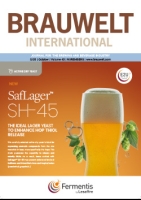
Limiting quality | Annual quality assessment of malting barley has shown a clear tendency towards reduced protein contents for some years, see part 1 of this article series in BRAUWELT International, No. 4, 2025, pp. 206–209. The value-added chain will probably have to accept lower protein contents in malting cereals in the long term. What would technological approaches for processing low protein contents look like?

Climate-tolerant hop varieties | This article focusses on a holistic, neutral overview of a selection of new aroma hop varieties from publicly subsidised hop research and private hop breeding. It is important to carry out adequate tests in breweries in order to maintain the aroma profiles of existing beers and to continue to offer customers a consistent quality.

Dynamic fermentation system | Non-alcoholic beers can be produced by dynamic fermentation using units like Poseidon and crabtree-negative yeasts. Targeted adjustments to recirculation and sedimentation processes in the fermentation tank make it possible to achieve high quality in the beers produced and increase the efficiency of individual processes.

Hops and beer flavour | What are aged hops? Aged hops have been traditionally used in Lambic style beer, and usually impart an unpleasant cheesy aroma [1], which is contributed by branched chain fatty acids (BCFAs) formed by oxidative degradation of hop bitter acids during the ageing process.

Increasing efficiency | The economic situation is currently challenging for many breweries. Regardless of the reasons, it is essential for efficient and thus sustainable operations to use the raw materials as effectively as possible. This article describes the Hopnomic technology introduced by Steinecker GmbH in 2020, a new approach to increasing efficiency in hop utilization.

Limiting quality (LQ) | Protein content in malting barley and the resulting nitrogen fractions in malt, wort and beer have major repercussions for malt and beer production from a technological point of view as well as for quality of the sales beer product. Free amino nitrogen, e.g., is used as yeast nutrient or coagulable nitrogen impacts foam stability of beer. As far as the protein content in barley or malt is concerned, technological orientation values within the so-called limit values referenced should be complied with to avoid jeopardising processability as well as quality.

Hop bitterness | Compared with sweet, salty, sour and umami, our sense of bitter taste is the odd one out, as it’s the least researched and the perception thereof and impact of its various constituents are rather complex. The positive properties of bitter substances for the human organism are becoming more widely acknowledged – as are those of hops. It’s thus worth breweries developing the bitterness of their products.

Innovative technology | Regular quality control of germination parameters in malting barley is essential for successful malting. A newly developed fast, simple and sound method can predict key traits of seed quality – germination capacity, germination energy, water sensitivity, and germination index. Based on a single test, all relevant germination parameters can be predicted using AI, thereby overcoming the well-known challenges associated with conventional barley testing — such as lengthy procedures, significant investment, and labor-intensive tasks.

Hop microbiome | Searches for new yeasts suitable for use in brewing have been ongoing for some time. A substantial part of domestic and foreign botany has been cartographically mapped for yeasts. But it is still quite surprising that one of the most important brewing ingredients has hardly been researched in that respect: namely hops. The authors and their students at FH Joanneum University of Applied Sciences have asked themselves: Which yeasts can be found on hops?
Nuremberg | The figures were eagerly awaited. On July 22, 2025, the time had come: Heinrich Meier and Thomas Raiser presented the new BarthHaas Report 2024/2025 at an online press conference, and they did not only have positive news to report.

Europe | Even though there were regionally dry conditions for spring barley growth in the spring, sufficient supply is currently expected from the coming harvest. In addition, the initial results for winter malting barley are promising.




